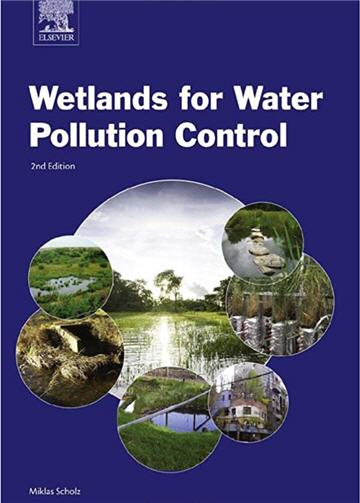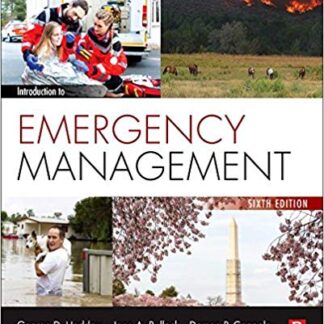Description
Wetlands for Water Pollution Control 2nd Edition, ISBN-13: 978-0444636072
[PDF eBook eTextbook]
- Publisher: Elsevier Science; 2nd edition (January 2, 2016)
- Language: English
- 556 pages
- ISBN-10: 0444636072
- ISBN-13: 978-0444636072
Wetlands for Water Pollution Control, Second Edition, covers the fundamental science and engineering principles relevant to the drainage and treatment of both storm and wastewater. Standard and novel design recommendations for predominantly constructed wetlands and related sustainable drainage systems are also provided to account for the interests of professional engineers and environmental scientists.
This revised edition deals with the design, operation, maintenance, and water quality monitoring of traditional and novel wetland systems, but also provides information on the analysis of asset performance and modeling of treatment processes, along with performances of existing infrastructures in predominantly developed, but also developing countries, and the sustainability and economic issues involved.
This new edition contains 10 new chapters, along with multidisciplinary, experimental, and modeling-orientated case study topics that include natural wetlands, constructed treatment wetlands for pollution control, sustainable drainage systems, and specific applications, such as wetlands treating hydrocarbon and ammonia, as well as ecological sanitation systems recycling treated.
- Contains a broad overview of water and environmental engineering aspects relevant for the drainage and treatment of storm water and wastewater, respectively
- Includes standard and novel design, operation, monitoring and maintenance recommendations for predominantly constructed wetlands and related sustainable drainage systems
- Provides detailed solutions to pressing water quality challenges associated with constructed treatment wetlands, integrated constructed wetlands, sustainable flood retention basins, farm constructed wetlands and storm water ponds, and other sustainable biological filtration and treatment technologies linked to public health engineering
Table of Contents:
1. Water quality standards 2. Water treatment 3. Sewage treatment 4. Stream pollution and effluent standards 5. Preliminary treatment 6. Primary treatment 7. Coagulation and flocculation 8. Sludge blanket clarifiers 9. Flotation systems 10. Slow filtration 11. Rapid filtration 12. Biological treatment 13. Biological filtration 14. Rotating biological contactors 15. Activated sludge processes 16. Iron and manganese removal 17. Water softening 18. Water microbiology 19. Disinfection 20. Constructed wetlands 21. Sludge treatment and disposal 22. Wetlands treating contaminated stream water 23. Wetland systems to control roof runoff 24. Wetlands treating road runoff 25. Combined wetland and below ground detention systems 26. Modeling of constructed wetland performance 27. Infiltration wetland systems 28. Retrofitting of Sustainable Drainage Systems in the Presence of Vegetation 29. Expert Tool Based on Ecosystem Variables for Retrofitting of Wetland Systems 30. Sustainable drainage system model 31. Natural wetlands treating diffuse pollution 32. Integrated constructed wetlands for pollution control 33. Infiltration and contaminant migration beneath integrated constructed wetlands 34. Seasonal assessment of vertical-flow wetlands treating domestic wastewater 35. Recycling of domestic wastewater treated by vertical-flow wetlands for irrigation 36. Piggery wastewater treatment with integrated constructed wetlands 37. Wetland systems as part of the Sustainable Flood Retention Basin concept 38. Classification of Sustainable Flood Retention Basins
Prof. Miklas Scholz, cand ing, BEng (equiv), PgC, MSc, PhD, CWEM, CEnv, CSci, CEng, FHEA, FIEMA, FCIWEM, FICE, Fellow of IWA holds the Chair in Civil Engineering at The University of Salford. He was previously working at The University of Edinburgh. He is the Head of the Civil Engineering Research Group in Salford.
He has shown individual excellence evidenced by contributions to world-leading publications, postgraduate supervision, and research impact. His main research areas in terms of publication output are treatment wetlands, integrated constructed wetlands, sustainable flood retention basins, permeable pavement systems, decision support systems, ponds, and capillary suction time. About 45% and 40% of his research is in water resources management and wastewater treatment, respectively. The remaining 15% is in capillary processes and water treatment.
He has published four books and more than 176 journal articles covering a wide area of topics. Between 2009 and 2015, he topped the publication list in terms of numbers for all members of staff at The University of Salford. Prof. Scholz’s full journal article publications in recent years are as follows: 2009 (13), 2010 (19), 2011 (13), 2012 (21), 2013 (17), and 2014 (15). He has total citations of more than 2845 (above 2122 citations since 2010), resulting in an H-Index of 28 and an i10-Index of 64.
Prof. Scholz is Editor-in-Chief of 13 journals, including the Web of Science-listed journal Water (impact factor for 2014: 1.428). He has membership experience on over 35 influential editorial boards. His new guidelines on sustainable flood retention basins (SFRB) and integrated constructed wetlands (ICW) have led to the international uptake of both the novel SFRB and ICW concepts. This work has particularly benefited the British Isles, Central and Northern Europe, and has an excellent uptake potential for large regions in America, Asia and Africa.
What makes us different?
• Instant Download
• Always Competitive Pricing
• 100% Privacy
• FREE Sample Available
• 24-7 LIVE Customer Support




